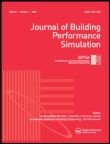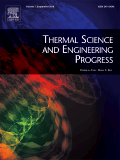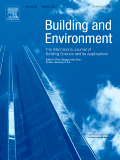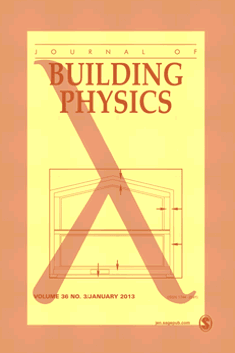
Journal of Building Performance Simulation
Scope & Guideline
Pioneering Research for a Sustainable Built Environment
Introduction
Aims and Scopes
- Building Energy Modeling:
Research in this area emphasizes the development and application of models to predict energy consumption, thermal performance, and environmental impact of buildings, using both traditional and advanced simulation techniques. - Machine Learning and Data-Driven Approaches:
This scope includes the use of machine learning algorithms to improve building performance predictions, optimize control strategies, and analyze occupant behavior, highlighting the journal's commitment to innovative computational methods. - Thermal Comfort and Indoor Environment:
Papers often explore the relationship between building design, thermal comfort, and indoor air quality, focusing on how these factors affect occupant satisfaction and health. - Resilience and Adaptation to Climate Change:
This area addresses the need for buildings to adapt to extreme weather events and climate change through innovative design and retrofitting strategies, ensuring long-term sustainability. - Integration of Renewable Energy Systems:
Research frequently investigates the incorporation of renewable energy technologies, such as solar and geothermal systems, into building designs, assessing their performance and impact on energy efficiency. - Building Simulation and Control Strategies:
The journal emphasizes advancements in simulation tools and control methodologies, aiming to enhance operational efficiency and energy management within building systems.
Trending and Emerging
- Advanced Machine Learning Applications:
Recent publications increasingly leverage advanced machine learning techniques for predictive modeling and optimization in building performance, reflecting a broader trend towards data-driven approaches in the industry. - Digital Twin Technology:
The emergence of digital twin methodologies for real-time performance monitoring and simulation in buildings is a growing focus, indicating a shift towards integrated and responsive building management systems. - Resilience Planning and Climate Adaptation:
With climate change posing significant challenges, the journal is seeing a rise in studies that address building resilience and adaptation strategies, emphasizing the importance of sustainable design practices. - Occupant-Centric Design and Control:
Research is increasingly focused on occupant-centric approaches that prioritize user comfort and behavior, utilizing smart technologies to tailor building environments to individual needs. - Integration of Renewable Energy and Smart Grids:
There is a notable trend towards exploring the integration of renewable energy systems and smart grid technologies within building performance simulations, reflecting a growing emphasis on sustainability and energy independence.
Declining or Waning
- Traditional Energy Efficiency Metrics:
There has been a noticeable shift away from conventional metrics for assessing energy efficiency, as newer methodologies and machine learning approaches gain prominence, rendering older methods less relevant. - Generalized Occupant Behavior Studies:
Prior research often generalized occupant behavior without specific context; however, the trend is moving towards more nuanced, data-driven studies that consider specific demographics and behaviors, leading to a decline in broad occupant studies. - Static Building Performance Assessments:
Static models that do not account for dynamic variables or real-time data have become less favored, as the field increasingly values adaptive and responsive simulation techniques. - Basic HVAC System Evaluations:
Research focusing solely on traditional HVAC systems without integrating smart technologies or advanced controls is becoming less common, as the journal emphasizes innovative control strategies that enhance energy performance.
Similar Journals

International Journal of Ventilation
Elevating Standards in Ventilation ResearchThe International Journal of Ventilation, published by Taylor & Francis Ltd, serves as a critical platform for the dissemination of innovative research in the fields of building and construction, civil and structural engineering, control and systems engineering, and electrical and electronic engineering. With an ISSN of 1473-3315 and an e-ISSN of 2044-4044, this esteemed journal has maintained a significant presence since its inception in 2005 and continues to provide valuable insights for academics and professionals alike until 2024. Recognized in the 2023 rankings, it holds a Q2 designation in Building and Construction and Q3 status in several other engineering categories, reflecting its solid standing in the academic community. Despite its non-open access format, the journal remains a vital resource, focusing on advanced ventilation solutions that shape sustainable practices in building design and engineering systems. By publishing high-quality peer-reviewed articles, the International Journal of Ventilation plays a pivotal role in advancing knowledge, fostering collaboration, and inspiring future research within its dynamic fields of study.

Russian Journal of Building Construction and Architecture
Connecting Theory and Practice in Sustainable DevelopmentRussian Journal of Building Construction and Architecture (ISSN: 2542-0526; E-ISSN: 2542-0526), published by the esteemed Voronezh State Technical University, serves as a vital platform for disseminating innovative research and practical applications in the fields of building construction and architecture. This journal, situated in Voronezh, Russia, aims to explore both the theoretical and empirical aspects of contemporary architecture and construction practices, fostering a robust dialogue among researchers, professionals, and academics. With an emphasis on open access to knowledge, the journal significantly contributes to global discourse by ensuring that findings are accessible to a wide audience. Underlining the importance of sustainable development and cutting-edge technologies in construction, the journal strives to publish high-quality research that addresses the challenges faced in today’s building environment, making it an invaluable resource for those committed to advancing the industry.

Journal of Control Automation and Electrical Systems
Transforming Ideas into Innovations in AutomationThe Journal of Control Automation and Electrical Systems, published by SPRINGER, is a prominent academic journal dedicated to advancing research in the interdisciplinary fields of control systems, automation, and electrical engineering. With an ISSN of 2195-3880 and E-ISSN of 2195-3899, this journal has emerged as a vital platform for disseminating high-quality research, contributing significantly to both theoretical and applied aspects of these interrelated domains. As of 2023, it ranks in the Q2 and Q3 quartiles across multiple categories, including Electrical and Electronic Engineering and Energy Engineering, showcasing its relevance and impact in the field. Although not an open-access journal, it provides rich access options for research works, ensuring that findings reach a wide audience. Researchers, professionals, and students alike can draw valuable insights from its curated articles that explore emerging trends, innovative technologies, and practical applications, thus reinforcing its position as a key contributor to the advancement of control and automation systems.

Thermal Science and Engineering Progress
Bridging theory and practice in thermal science.Thermal Science and Engineering Progress is a premier peer-reviewed journal published by ELSEVIER, established to bridge the gap between theoretical and practical advancements within the fields of thermal science and engineering. Since its inception in 2017, this esteemed journal has rapidly ascended to a Q1 ranking in the category of Fluid Flow and Transfer Processes, positioning it among the top 17 of 96 journals in this discipline, as reflected by its impressive 82nd percentile ranking in Scopus. With a focus on disseminating high-impact research, Thermal Science and Engineering Progress aims to foster innovation and collaboration by publishing cutting-edge studies that address both contemporary challenges and future directions in thermal management, energy conversion, and heat transfer technologies. Researchers, professionals, and students alike are invited to explore the wealth of knowledge contained within its pages, which are accessible from its headquarters in Amsterdam, Netherlands. This journal plays a critical role in advancing technological progress and fostering a deeper understanding of thermal processes, making it an essential resource for anyone dedicated to these crucial areas of study.

BUILDING AND ENVIRONMENT
Building a greener tomorrow through impactful research.BUILDING AND ENVIRONMENT, published by Pergamon-Elsevier Science Ltd, stands as a premier journal in the fields of Building and Construction, Civil and Structural Engineering, Environmental Engineering, and Geography, Planning, and Development. With its ISSN 0360-1323 and E-ISSN 1873-684X, this esteemed publication has garnered significant acclaim, achieving a Q1 ranking in multiple categories for 2023, reflecting its influential role in advancing research and innovation within these domains. Spanning from 1976 to 2024, the journal invites contributions that explore the intersection of sustainable design, energy efficiency, and urban development, addressing critical issues faced in modern architecture and environmental impact. Although it does not offer open access, its comprehensive articles and reviews are pivotal for researchers, professionals, and students dedicated to creating sustainable built environments. Situated in the United Kingdom, the journal serves as a vital resource for those aiming to contribute to the knowledge base in this rapidly evolving ecologically focused field.

Journal of Building Physics
Transforming Building Science Through Rigorous ResearchThe Journal of Building Physics, published by SAGE PUBLICATIONS LTD, has established itself as a leading publication within the fields of Building and Construction as well as Materials Science. With a robust Scopus ranking, including a commendable Q2 designation in both categories in 2023, this journal serves as a crucial platform for researchers and professionals aiming to advance the understanding of building performance and thermal dynamics. Operating from the vibrant academic landscape of the United Kingdom, the journal showcases innovative research and critical analyses that enhance sustainable building practices, contributing significantly to the literature from 2000 to 2024. Though it does not currently offer open access, the Journal of Building Physics continues to publish highly-cited work that resonates with its audience, facilitating knowledge exchange and encouraging scholarly dialogue among students, practitioners, and researchers eager to push the boundaries of building sciences.

Building Simulation
Transforming Building Performance with Simulation InsightsBuilding Simulation is a leading academic journal published by TSINGHUA UNIVERSITY PRESS, focusing on the critical intersection of building and construction and energy efficiency. With its ISSN 1996-3599 and E-ISSN 1996-8744, this journal stands out in the Q1 category for both Building and Construction and Energy (miscellaneous), as recognized in the latest 2023 category quartiles. It has established itself as an influential platform for disseminating innovative research and developments in building performance simulation and energy use optimization, boasting impressive Scopus rankings at Rank #15/223 in Engineering (Building and Construction) and Rank #15/78 in Energy (miscellaneous), placing it in the upper percentiles of its field. Since its inception in 2008, the journal has fostered a rich dialogue among practitioners, researchers, and students, empowering them to advance sustainable building practices and contribute to global energy conservation efforts. Building Simulation is an open-access journal, making its valuable content accessible to a worldwide audience, further enhancing its role as a vital resource in the quest for innovative building solutions.

APPLIED THERMAL ENGINEERING
Advancing thermal innovation for a sustainable future.Applied Thermal Engineering is a leading international journal dedicated to the field of thermal engineering, published by Pergamon-Elsevier Science Ltd. With an impressive impact factor indicating its significance in the academic community, this journal focuses on innovative research and developments related to energy engineering, fluid flow, and transfer processes, as well as manufacturing and mechanical engineering. Being indexed in top quartiles (Q1) across multiple categories, it ranks exceptionally well on platforms like Scopus, ensuring that contributors reach a wide and relevant audience. The journal supports both open access and subscription options, promoting the dissemination of vital research findings from 1996 to 2024. With its commitment to advancing the discipline and implementing rigorous peer-review processes, Applied Thermal Engineering serves as an essential resource for researchers, industry professionals, and students aiming to stay abreast of the latest advancements and applied methodologies in thermal science.

International Journal of Building Pathology and Adaptation
Exploring innovative pathways to building preservation.International Journal of Building Pathology and Adaptation is a premier publication dedicated to advancing knowledge in the field of building pathology and adaptation. Established by the esteemed Emerald Group Publishing Ltd, this journal serves as a vital platform for researchers and practitioners focusing on the assessment, preservation, and innovative adaptation of built environments. With an impressive Q2 ranking in both Building and Construction and Civil and Structural Engineering, and a Scopus ranking of #62 out of 223 in the relevant engineering disciplines, the journal showcases high-quality research with significant practical implications. Although currently not featuring an open-access model, its access options cater to a wide audience aiming to explore cutting-edge studies from 2017 to 2024. The journal's commitment to bridging the gap between academic inquiry and real-world application makes it an essential resource for anyone dedicated to advancing the resilience and sustainability of the built environment.

BUILDING RESEARCH AND INFORMATION
Fostering interdisciplinary insights for the built environment.BUILDING RESEARCH AND INFORMATION is a premier academic journal dedicated to the advancement of knowledge in the fields of Building and Construction as well as Civil and Structural Engineering. Published by Routledge Journals, Taylor & Francis Ltd, this journal boasts an impressive Q1 ranking in both categories as of 2023, emphasizing its reputation for disseminating high-quality research. Established in 1991, it has continually provided a vital platform for scholarly dialogue on innovative building practices, sustainable construction techniques, and cutting-edge engineering solutions, with ongoing contributions accepted until 2024. The journal is renowned for its extensive insights and interdisciplinary approach, and with a Scopus rank placing it in the 88th percentile for both building and construction engineering and civil and structural engineering, it presents an exceptional opportunity for researchers, professionals, and students to engage with and publish influential findings. While the journal is not open access, it remains a cornerstone for those aiming to deepen their understanding of contemporary challenges and trends in the built environment.